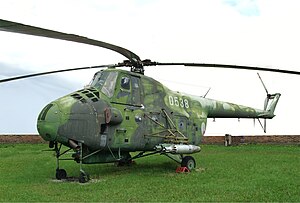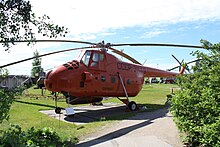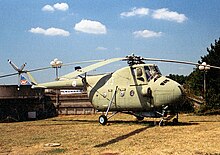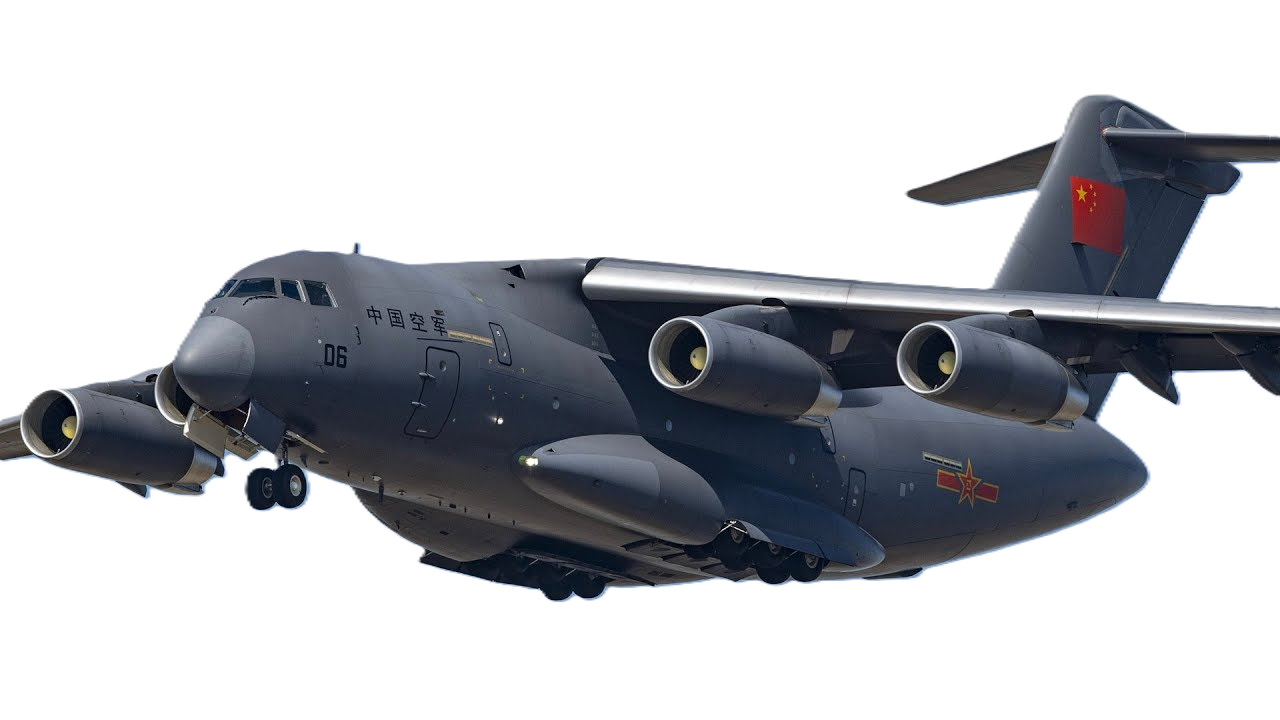Mil Moscow Plant
Mil Mi-4 Hound
 |
|
| General information | |
|---|---|
| Type | Transport helicopter |
| Manufacturer | Mil Moscow Helicopter Plant |
| Status | Limited Service; North Korean Air Force |
| Primary users | Soviet Air ForcePolish Air Force Royal Afghan Air Force |
| Number built | over 4,000 including Z-5s |
| History | |
| Manufactured | 1951–1979 |
| Introduction date | 1953 |
| First flight | 3 June 1952 |
| Variants | Harbin Z-5 |
|
|
|
|
|---|
.
History Mil Moscow Helicpter plant
Mil Mi-4 type 36
NATO reporting name:
'Hound'
-
Design

Mil Mi-4 of the Finnish Airforce The Mi-4 transport helicopter laid the groundwork of Soviet Army Aviation. It was widely used both in the armed forces and in Soviet civil aviation, and for several decades remained the main type of helicopter in the inventory of the Soviet Armed Forces and of the Civil Air Fleet. The Mi-4 went out of service with the development of the Mi-8. It is no longer used by the Russian Air Force, though it remained in service in some countries as a utility helicopter or as a military transport a while longer. Albania was thought to be the final country using the helicopter, and by 2005 all were out of service. The Mi-4 played a very important role in the Bangladesh liberation war of 1971. The Mi-4 was the workhorse of the Indian Air Force[5] covering the medium lift role at the time. A highly successful heli-borne operation, the Meghna Heli Bridge, using Mi-4s helped the Indian Army's 57 Mountain Division clear the Meghna River. The helilift of a battalion of Indian troops to the outskirts of Sylhet was the first heli-borne operation of the Indian army.
Variants Military

MI-4 in Riga aviation museum 
A Mil Mi-4 at Belgrade Aviation Museum
0
KmCeiling
0
KmMAX RANGE
0
Km.hAircraft Speed
0
Max Crew
Photo Gallery
JMil Moscow Helicpter plant
Mil Mi-4 type 36
NATO reporting name:
'Hound'


Mil Moscow Helicpter plant Mil Mi-4 type 36 NATO reporting name: 'Hound'
General characteristics
- Crew: 1
- Length: 16 m (52 ft 6 in)
- Height: 4.93 m (16 ft 2 in)
- Empty weight: 7,700 kg
- Gross weight: 9,800 kg (21,605 lb)
- Max takeoff weight: 10,800 kg
-
Powerplant
- Powerplant: 2 × Klimov VK-2500 turboshaft engines, (2,400 shp) each
- Main rotor diameter: 2 × 14.5 m
- Main rotor area: 330.3 m2 (3,555 sq ft) contra-rotating 3-bladed main rotors
Specifications
- Maximum speed: 315 km/h
- Cruise speed: 270 km/h
- Never exceed speed: 350 km/h
- Range: 545 km (339 mi, 294 nmi)
- Combat range: 470 km
- Ferry range: 1,160 km
- Service ceiling: 5,500 m (18,000 ft)
Armament
-
-
-
- Guns: 1 × mobile semi-rigid 30 mm Shipunov 2A42 cannon (460 rounds total, dual feeding AP or HE-Frag)
- Hardpoints: 6 × under-wing hardpoints, plus 2 on wingtips for countermeasures or air-to-air missiles with a capacity of 2,000 k
-
-
-
-
Links to Youtube & Others
The Mi-4 transport helicopter laid the groundwork of Soviet Army Aviation. It was widely used both in the armed forces and in Soviet civil aviation, and for several decades remained the main type of helicopter in the inventory of the Soviet Armed Forces and of the Civil Air Fleet.
Mil Moscow Helicpter Mil Mi-4 type 36 'Hound'
The Mil Mi-4 (USAF/DoD reporting name "Type 36",[1] NATO reporting name "Hound")
Youtube Link
An official video of a North Korean Air Force combat flying skills competition released in 2014 shows that the Mi-4 is still in limited service in North Korea











.png)


.png)